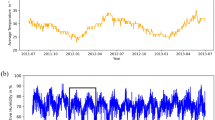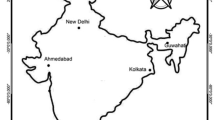Abstract
Today, air temperature (AT) is the most critical climatic indicator. This indicator accurately defines global warming and climate change, despite the fact that it has effects on different things, including the environment, hydrology, agriculture, and irrigation. Accurate and timely AT forecasting is crucial since it supplies more significant details that can create credibility for future planning. This study proposes innovative hybrid models that integrate a convolutional neural network (CNN) with a long short-term memory (LSTM) neural network and a gated recurrent unit (GRU) to perform one-day ahead AT predictions. For this purpose, the daily AT data obtained from 2012 to 2019 at the Adana and Ankara meteorological stations over Türkiye under Continental and Mediterranean climate conditions are used. The hybrid GRU-CNN and LSTM-CNN models are compared with various traditional statistical and machine-learning models such as feed-forward neural network, adaptive neuro-fuzzy inference system, autoregressive moving average, GRU, CNN, and LSTM. The success of the prediction models is evaluated utilizing various statistical criteria (MAE, RMSE, NSE, and R2) and visual comparisons. The results show that the proposed hybrid GRU-CNN and LSTM-CNN models in one day-ahead AT predictions yield the best results among all models with high accuracy.


















Similar content being viewed by others
References
Abdel-Nasser M, Mahmoud K (2019) Accurate photovoltaic power forecasting models using deep LSTM-RNN. Neural Comput Appl 31:2727–2740
Abu-Salih B, Wongthongtham P, Morrison G, Coutinho K, Al-Okaily M, Huneiti A (2022) Short-term renewable energy consumption and generation forecasting: a case study of Western Australia. Heliyon 8(3):e09152
Aghelpour P, Mohammadi B, Biazar SM (2019) Long-term monthly average temperature forecasting in some climate types of Iran, using the models SARIMA, SVR, and SVR-FA. Theoret Appl Climatol 138(3–4):1471–1480
Akdi Y, Ünlü KD (2021) Periodicity in precipitation and temperature for monthly data of Turkey. Theoret Appl Climatol 143:957–968
Alomar MK, Khaleel F, Aljumaily MM, Masood A, Razali SFM, AlSaadi MA, Al-Ansari N, Hameed MM (2022) Data-driven models for atmospheric air temperature forecasting at a continental climate region. PLoS ONE 17(11):e0277079
ArunKumar KE, Kalaga DV, Kumar CMS, Kawaji M, Brenza TM (2022) Comparative analysis of Gated Recurrent Units (GRU), long Short-Term memory (LSTM) cells, autoregressive Integrated moving average (ARIMA), seasonal autoregressive Integrated moving average (SARIMA) for forecasting COVID-19 trends. Alex Eng J 61(10):7585–7603
Azari A, Zeynoddin M, Ebtehaj I, Sattar AM, Gharabaghi B, Bonakdari H (2021) Integrated preprocessing techniques with linear stochastic approaches in groundwater level forecasting. Acta Geophys 69(4):1395–1411
Bajirao TS, Elbeltagi A, Kumar M, Pham QB (2022) Applicability of machine learning techniques for multi-time step ahead runoff forecasting. Acta Geophys 70(2):757–776
Box GEP, Jenkins GM (1976) Time series analysis: forecasting and control, Revised. Holden-Day, San Francisco
Cho K, Van Merriënboer B, Gulcehre C, Bahdanau D, Bougares F, Schwenk H, Bengio Y (2014) Learning phrase representations using RNN encoder-decoder for statistical machine translation. arXiv preprint arXiv:1406.1078
Cho M, Kim C, Jung K, Jung H (2022) Water level prediction model applying a long short-term memory (lstm)–gated recurrent unit (gru) method for flood prediction. Water 14(14):2221
Dariane AB, Behbahani MM (2023) Development of an efficient input selection method for NN based streamflow model. J Appl Water Eng Res 11(1):127–140
García-Duarte Sáenz L, Cifuentes Quintero J, Marulanda G (2023) Short-term spatio-temporal forecasting of air temperatures using deep graph convolutional neural networks. Available at SSRN 3988117
Gezici K, Şengül S (2023) Estimation and analysis of missing temperature data in high altitude and snow-dominated regions using various machine learning methods. Environ Monit Assess 195(4):1–19
GISTEMP Team (2023) GISS Surface Temperature Analysis (GISTEMP), version 4. NASA Goddard Institute for Space Studies. https://data.giss.nasa.gov/gistemp/
Goyal MK, Bharti B, Quilty J, Adamowski J, Pandey A (2014) Modeling of daily pan evaporation in sub-tropical climates using ANN, LS-SVR, Fuzzy Logic, and ANFIS. Expert Syst Appl 41(11):5267–5276
Hilaire J, Minx JC, Callaghan MW, Edmonds J, Luderer G, Nemet GF, Rogelj J, del Mar Zamora M (2019) Negative emissions and international climate goals—learning from and about mitigation scenarios. Clim Change 157:189–219
Hou J, Wang Y, Zhou J, Tian Q (2022) Prediction of hourly air temperature based on CNN–LSTM. Geomat Nat Hazard Risk 13(1):1962–1986
Hou J, Wang Y, Hou B, Zhou J, Tian Q (2023) Spatial simulation and prediction of air temperature based on CNN-LSTM. Appl Artif Intell 37(1):2166235
Hua G, Wang S, Xiao M, Hu S (2023) Research on the uplift pressure prediction of concrete dams based on the CNN-GRU model. Water 15(2):319
IPCC (2018) Global warming of 1.5°C. An IPCC Special Report on the impacts of global warming of 1.5°C above pre-industrial levels and related global greenhouse gas emission pathways, in the context of strengthening the global response to the threat of climate change, sustainable development, and efforts to eradicate poverty. In: Masson-Delmotte V, Zhai P, Pörtner HO, Roberts D, Skea J, Shukla PR, Pirani A, Moufouma-Okia W, Péan C, Pidcock R, Connors S, Matthews JBR, Chen Y, Zhou X, Gomis MI, Lonnoy E, Maycock T, Tignor M, Waterfield T (eds). Cambridge University Press, Cambridge, New York, p 616. https://doi.org/10.1017/9781009157940
Jang JS (1993) ANFIS: adaptive-network-based fuzzy inference system. IEEE Trans Syst Man Cybern 23(3):665–685
Kabbilawsh P, Sathish Kumar D, Chithra NR (2020) Trend analysis and SARIMA forecasting of mean maximum and mean minimum monthly temperature for the state of Kerala, India. Acta Geophys 68:1161–1174
Katipoğlu OM (2022) Prediction of missing temperature data using different machine learning methods. Arab J Geosci 15(1):21
Kaur J, Parmar KS, Singh S (2023) Autoregressive models in environmental forecasting time series: a theoretical and application review. Environ Sci Pollut Res 30(8):19617–19641
Lenssen N, Schmidt G, Hansen J, Menne M, Persin A, Ruedy R, Zyss D (2019) Improvements in the GISTEMP uncertainty model. J Geophys Res Atmos 124(12):6307–6326. https://doi.org/10.1029/2018JD029522
Loganathan N, Ibrahim Y (2010) Forecasting international tourism demand in Malaysia using Box Jenkins SARIMA application. South Asian J Tour Herit 3(2):50–60
Massaoudi M, Chihi I, Sidhom L et al (2021) An effective hybrid NARX-LSTM model for point and interval PV power forecasting. IEEE Access 9:36571–36588
Mazarei Behbahani MR, Mazarei A (2023) A new criteria for determining the best decomposition level and filter for wavelet-based data-driven forecasting frameworks-validating using three case studies on the CAMELS dataset. Stoch Environ Res Risk Assess. https://doi.org/10.1007/s00477-023-02531-z
Modaresi F, Araghinejad S, Ebrahimi K (2018) A comparative assessment of artificial neural network, generalized regression neural network, least-square support vector regression, and K-nearest neighbor regression for monthly streamflow forecasting in linear and nonlinear conditions. Water Resour Manag 32:243–258
Moghaddamnia A, Remesan R, Kashani MH, Mohammadi M, Han D, Piri J (2009) Comparison of LLR, MLP, Elman, NNARX and ANFIS Models—with a case study in solar radiation estimation. J Atmos Solar Terr Phys 71(8–9):975–982
Mohammadi B, Mehdizadeh S, Ahmadi F, Lien NTT, Linh NTT, Pham QB (2021) Developing hybrid time series and artificial intelligence models for estimating air temperatures. Stoch Env Res Risk Assess 35:1189–1204
Morice CP, Kennedy JJ, Rayner NA, Winn JP, Hogan E, Killick RE et al (2021) An updated assessment of near-surface temperature change from 1850: the HadCRUT5 data set. J Geophys Res Atmos 126:e2019JD032361
Ourworldindata, Average Temperature Anomaly Global (2023) https://ourworldindata.org/grapher/temperature-anomaly?country=~Global. Accessed 1 April 2023
Ozbek A (2023) Deep learning approach for one-hour ahead forecasting of weather data. Energy Sources Part A Recovery Util Environ Effects 45(3):7606–7628
Ozbek A, Sekertekin A, Bilgili M, Arslan N (2021) Prediction of 10-min, hourly, and daily atmospheric air temperature: comparison of LSTM, ANFIS-FCM, and ARMA. Arab J Geosci 14:1–16
Phyo PP, Byun YC (2021) Hybrid ensemble deep learning-based approach for time series energy prediction. Symmetry 13(10):1942
Rajagopalan S, Santoso S (2009) Wind power forecasting and error analysis using the autoregressive moving average modeling. In 2009 IEEE power & energy society general meeting. IEEE, pp 1–6
Sahoo BB, Jha R, Singh A, Kumar D (2019) Long short-term memory (LSTM) recurrent neural network for low-flow hydrological time series forecasting. Acta Geophys 67(5):1471–1481
Santos CAG, do Nascimento GR, de Farias CAS, da Silva RM, Mishra M (2023) Short-and long-term streamflow forecasting using wavelet neural networks for complex watersheds: a case study in the Mahanadi River, India. Ecol Inform 73:101945
Sekertekin A, Bilgili M, Arslan N, Yildirim A, Celebi K, Ozbek A (2021) Short-term air temperature prediction by adaptive neuro-fuzzy inference system (ANFIS) and long short-term memory (LSTM) network. Meteorol Atmos Phys 133:943–959
Sekula P, Bokwa A, Bochenek B, Zimnoch M (2019) Prediction of air temperature in the Polish Western Carpathian Mountains with the ALADIN-HIRLAM numerical weather prediction system. Atmosphere 10(4):186
Sen D, Huseyinoglu MF, Günay ME (2023) Prediction of global temperature anomaly by machine learning based techniques. Neural Comput Appl. https://doi.org/10.1007/s00521-023-08580-3
TSMS (2023) Turkish State Meteorological Service. https://www.mgm.gov.tr/
(UNEP) United Nations Environment Programme (2021) Emissions Gap Report 2021. Nairobi. ISBN 978-92-807-3890-2
WHO (World Health Organization) (2023) Climate change and human health. https://www.who.int/globalchange/global-campaign/cop21/en/. Accessed May 2023
Wu S, Fu F, Wang L, Yang M, Dong S, He Y, Zhang Q, Guo R (2022) Short-term regional temperature prediction based on deep spatial and temporal networks. Atmosphere 13(12):1948
Yonar A, Yonar H (2023) Modeling air pollution by integrating ANFIS and metaheuristic algorithms. Model Earth Syst Environ 9:1621–1631
Younis R, Zerr S, Ahmadi Z (2022) Multivariate time series analysis: an interpretable CNN-based model. In: 2022 IEEE 9th international conference on data science and advanced analytics (DSAA). IEEE, pp 1–10
Zakhrouf M, Bouchelkia H, Stamboul M, Kim S (2020) Novel hybrid approaches based on evolutionary strategy for streamflow forecasting in the Chellif River, Algeria. Acta Geophys 68:167–180
Zhang Z, Dong Y (2020) Temperature forecasting via convolutional recurrent neural networks based on time-series data. Complexity 2020:1–8
Zhang X, Tan SC, Li G (2014) Development of an ambient air temperature prediction model. Energy Build 73:166–170
Zhu S, Piotrowski AP (2020) River/stream water temperature forecasting using artificial intelligence models: a systematic review. Acta Geophys 68:1433–1442
Acknowledgements
The author wishes to thank the Turkish State Meteorological Service for supplying data.
Funding
Author did not receive any funding for the work.
Author information
Authors and Affiliations
Contributions
All authors contributed to the study's conception and design. IU and MB performed material preparation, data collection, and analysis. IU wrote the first draft of the manuscript and all authors commented on previous versions of the manuscript. All authors read and approved the final manuscript.
Corresponding author
Ethics declarations
Conflict of interest
On behalf of all authors, the corresponding author states that there is no conflict of interest.
Additional information
Edited by Dr. Ahmad Sharafati (ASSOCIATE EDITOR) / Prof. Theodore Karacostas (CO-EDITOR-IN-CHIEF).
Rights and permissions
Springer Nature or its licensor (e.g. a society or other partner) holds exclusive rights to this article under a publishing agreement with the author(s) or other rightsholder(s); author self-archiving of the accepted manuscript version of this article is solely governed by the terms of such publishing agreement and applicable law.
About this article
Cite this article
Uluocak, I., Bilgili, M. Daily air temperature forecasting using LSTM-CNN and GRU-CNN models. Acta Geophys. 72, 2107–2126 (2024). https://doi.org/10.1007/s11600-023-01241-y
Received:
Accepted:
Published:
Issue Date:
DOI: https://doi.org/10.1007/s11600-023-01241-y




